
John Betts - Fine Minerals > Home Page> Educational Articles > The Minerals of New York City > Page 3 |

Go to Previous Page, Page 1, Page 2, Page 3, Page 4, Next Page
Both Chabazite-Ca and Chabazite-K from NYC localities have been identified by the NYSM. The exact species of each NYC specimen is not known and will be referred to by the group name chabazite in this article. Translucent yellow-tan rhombohedral chabazite crystals to 5 mm occur in seams and cavities with other late-forming zeolite minerals in the bedrock throughout NYC. Hawkins (1945) reported that among the rock excavated during the construction of the Brooklyn-Battery Tunnel, at the southern end of Manhattan, well developed chabazite crystals were found exhibiting, "first and second order rhombohedrons and the basal plane." The NYMC collection has a large 20x18 cm plate completely coated on one face with 4 mm orange chabazite crystals from this locality.
Other noteworthy finds of chabazite include 5 mm chabazite crystals associated with orange stilbite from 45th Street and 1st Avenue; translucent pink chabazite crystals to 18 mm across from nearby at 2nd Avenue; broad seams of pink chabazite crystals to 3.5 mm from 100th Street and Parke Avenue; translucent orange chabazite crystals to 6 mm across from the 63rd Street subway excavation in Manhattan; small lustrous tan-colored chabazite crystals to 1 mm from the old Williams Bridge locality where Gunn Hill Road crosses the Bronx River.
|
Chabazite crystals to 6 mm from a NY Subway excavation, Manhattan, NY 13x8x3 cm overall. NYSM #18065. |
As mentioned previously, translucent yellow-green chrysoberyl crystals occur rarely in NYC, with only a handful of specimens known (see the Levison chrysoberyl section above for details of the two best specimens). Manchester (1940) reports collecting a well-developed transparent yellow chrysoberyl crystal at 164th Street and St. Nicholas Avenue in Manhattan. The chrysoberyl crystal is 10 mm long and nicely exposed along it's length from the surrounding pegmatite matrix. The specimen now resides in the NYMC collection. A.C. Hawkins collected a 22 mm translucent chrysoberyl crystal embedded in quartz-orthoclase pegmatite at 122nd Street and Morningside Avenue in Manhattan.
|
Chrysoberyl in pegmatite from 122nd St. in Morningside Park, Manhattan, NY
ex. A.C. Hawkins |
Dark crystals of clinochlore are widely represented in NYC collections, though few are aesthetic specimens. These old specimens are commonly labeled Ripidolite, the iron-rich variety of clinochlore. Clinochlore crystals occur as 5-15 mm mica-like dark green foliated crystals associated with quartz and albite in the rock excavated for the 63rd Street subway in Manhattan. Recently lilac-colored chrome-rich clinochlore microcrystals on greenish serpentine were recovered at an exposure on Lincoln Avenue in Staten Island.
The first find of columbite-(Fe) (reported as columbite) on Manhattan Island was in 1887 and is in the Kunz collection of the NYMC (Chamberlin, 1888). The columbite-(Fe) is embedded in albite and is a sharp crystal 12 mm long with well developed crystals faces. The specimen is listed simply as being from "Fort George" in upper Manhattan. Another significant find in the NYSM collection is an elongated 9 mm crystal with striated prism faces embedded in smoky quartz and yellow beryl from eastern end of 185th Street at the Harlem River.
|
Columbite-(Fe) from Fort George, Manhattan, possibly the first specimen found
of this mineral in NYC, |
One specimen in the NYSM collection from 55th Street in Manhattan has native copper associated with cuprite, azurite and malachite. The native copper has a dark patina and is exposed for several centimeters in the matrix. No other native copper specimens are known from NYC.
|
Copper, azurite and malachite from 55th Street, Manhattan, NY. Detail of a 13x11x7 cm specimen. NYSM 18066 |
The early literature commonly referred to malacolite, the obsolete mineral name for pale-colored diopside. The first mention in the literature is from Bruce (1814b). Diopside, forming blocky-to-prismatic crystals with white-to-crème-colored, complex terminations, embedded within the Inwood marble, were among the most common collectible species in the Kingsbridge section of Manhattan. Crystals to 12 cm long are known.
|
Pyroxene (Diopside) from Kingsbridge, Manhattan, NY., ex. Harvard, |
Both dravite and uvite tourmalines are found in NYC. Most are generically referred to as brown tourmaline, because exact species identification requires testing and a collector cannot rely on morphology to determine the species. Dravite crystals have been confirmed from the Inwood marble in the Kingsbridge section of upper Manhattan and the Bronx. Conklin (1997) reports all tourmaline crystals from the Kingsbridge area are either uvite or schorl -- this is incorrect. by Marian Lupulescu at the NYSM has confirmed dravite in seven specimens from the area from between Dyckman Street and 225th Street in the Kingsbridge section of Manhattan.
Because the exact tourmaline species of any given specimen is unknown for these "brown tourmalines" they will be collectively described here as dravite-uvite. Many large specimens of dravite-uvite are represented in all major collection,n with crystals to 7 cm known. One of the most frequented collecting areas for dravite-uvite was the rock dump near 218th Street and Broadway, near the current site of Columbia University's Baker Field. The rock fill surrounding Baker Field still produces rocks with dravite-uvite if access can be obtained to collect.
|
Dravite-Uvite tourmaline 22 mm long in Inwood Marble from west shore of northern
tip of Manhattan NY |
Occasionally the dravite-uvite crystals were transparent enough to produce faceted gemstones to 5 mm diameter. These gemstones are dark and usually internally flawed but show a nice yellow-brown flash of color. Manchester (1931) Plate No. 1 illustrates two square dravite-uvite tourmaline gemstones in the upper right corner.
Recently the author, along with Ted Zirnite, collected many translucent brown dravite crystals to 25 mm long in rock excavated for the Harlem Ship Canal that was dumped along the western shore of northern Manhattan Island (Betts, 1998). These tourmaline crystals occurred in granular gray Inwood marble in horizons of many dravite crystals. The tourmaline crystals are elongated prisms with shallow pyramidal terminations and are often in several segments frozen in the marble indicating post-crystallization deformation. At first the author labeled the specimens as dravite based on correspondence with Fred Pough, but after EDS testing of one specimen by a commercial testing service, they were identified as uvite. Most recently the NYSM tested another crystal from the same find and reported it was dravite. This example illustrates the difficulty in identifying the exact tourmaline species from this region.
|
Dravite-uvite crystal 12 mm long in Inwood Marble from fill north of Tubby
Hook, |
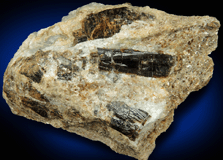
#353, Dravite-Uvite Tourmaline in Inwood Marble,
northwest corner of 207 Street and Broadway, Manhattan Island, New York
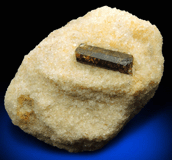
#348, Dravite-Uvite Tourmaline in Inwood Marble,
Marble Hill, Manhattan Island, New York
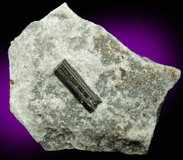
#368, Dravite-Uvite Tourmaline in Inwood Marble,
Harlem Ship Canal excavation, norther Manhattan Island, New York
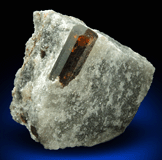
#369, Dravite-Uvite Tourmaline in Inwood Marble (best
of find), Harlem Ship Canal excavation, norther Manhattan Island,
New York
The 1881 discovery of dumortierite in France coincided with early collecting in NYC and local collectors were excited to find this mineral present in the rocks of Manhattan. Formerly this fibrous blue mineral was thought to be indicolite tourmaline, and it is possible that the "indicolite" from Harlem listed in Robinson (1825) was actually dumortierite. Local collectors soon identified dumortierite from the Harlem site at 120th Street. It was one of the earliest reports of dumortierite in the US, with the first published report by Riggs of dumortierite from Harlem in 1887. Most of the dumortierite specimens originated from 118th to 124th Streets, between Park and 5th Avenues in Harlem, though it has been found elsewhere, notably in the area south of I-95 in uptown Manhattan. Specimens range from blue-gray to baby-blue fibrous crystals commonly embedded in milky quartz.
Lustrous dark green epidote crystals are one of the more attractive minerals from NYC. Epidote was first reported by Robinson (1825) from the Bronx and at Corlaer's Hook on the western shore of the East River near 38th Street on Manhattan Island. Large epidote crystals 36 mm in length and 12 mm in diameter from Fort George, in upper Manhattan were reported by Kunz (1887) and 38 mm long lustrous green epidote crystals were recovered at a prolific occurrence at 59th Street between Avenue of the Americas and 7th Avenues were reported by Chamberlin (1888). Other notable finds include transparent green epidote crystals to 2 mm long associated with salmon-colored feldspar found on West 55th Street; translucent green epidote crystals to 2 mm long associated with 4-6 mm white albite crystals from 92nd Street and Park Avenue; elongated green epidote crystals to 3 mm long with limonite stained almandine crystals from 96th Street and 8th Avenue (Central Park West); and sharp green epidote crystal intergrown with quartz from 134th-135th Street and Broadway, all in Manhattan.
|
Epidote with albite on gneiss from 92nd St. & 4th Ave., Manhattan, NY ex. B.B. Chamberlin, 6x5 cm. NYMC #160. |
|
Epidote, quartz, orthoclase labeled as simply from Manhattan, NY., ex. Kunz. 16x9 cm. NYMC #174. |
Most specimens in NYC collections simply labeled as apatite are presumed to be fluorapatite and were first mentioned by Robinson in 1825. Fluorapatite crystals occur as stubby to elongated hexagonal crystals ranging from nearly colorless to dark brown with crystals rarely exceeding 4 cm long. S.C.H. Bailey recovered fine fluorapatite crystals associated with well crystallized muscovite and octahedral pyrite crystals at the Kip's Bay quarry in east midtown Manhattan (Chamberlin, 1888). Colorless fluorapatite crystals on smoky quartz matrix were recovered from a site one block from the Empire State Building (DeVito, 1969) The largest fluorapatite crystals reported were 15 cm long from 122nd Street near Riverside Drive (Chamberlin, 1888).
|
Fluorapatite and garnet from Aqueduct Shaft #26, 180th St. and 10th Ave, Manhattan, NY 11x8 cm, 1-4 mm crystals, NYMC #49. |
Microcrystals of fluorite have been found throughout NYC with a notable occurrence at 168th Street and the Harlem River of purple fluorite associated with the adularia variety of orthoclase in crystals to 5 mm across. Massive green fluorite was reported by Manchester (1914) from a subway excavation between 53rd and 54th Street in Manhattan. William Hidden recovered yellow and blue cubic fluorite crystals 6 mm across on gneiss from rock blasted during the excavation at Hell's Gate in the East River (Chamberlin, 1888).
|
Fluorite and orthoclase var. adularia from 168th Street and Harlem Speedway
(Harlem River Drive), |
Late-forming small cubic galena crystals occur with zeolites in fractures and joints in the schists and gneisses. Gray metallic galena crystals 4 mm across were found associated with harmotome and chabazite at 92nd Street and Park Avenue in Manhattan. A unique specimen in the SIIAS collection is a cleavage of metallic galena found in glacial drift on Grymes Hill in Staten Island.
|
Galena from glacial drift at Grymes Hill, Staten Island, 4 cm box Staten Island Museum #G1066. |
The iron oxides goethite and hematite were the principal ores of the Staten Island iron mines where they formed as weathering products of the serpentine associated with limonite-stained quartz. Botryoidal brown-black crystallized masses of goethite-hematite occur throughout the serpentine highlands of Staten Island.
|
Goethite from Staten Island, NY., 7x5 cm. Staten Island Museum #G3496. |
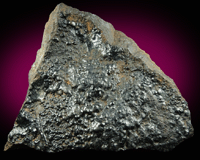
#338, Goethite, Emerson Hill iron mining district,
Staten Island, New York
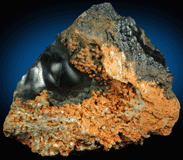
#339, Goethite, Quartz, Magnetite, Staten Island
Highlands iron mining district, New York
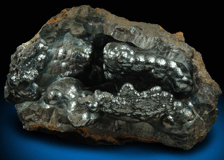
#325, Goethite-Hematite, Dongan Hills iron mining
district, Staten Island, New York
In 1907 the American Museum of Natural History Annual Report noted that Wallace Goold Levison donated to the museum a gold specimen found in NYC. But the current catalog of the AMNH does not list the gold specimen and is assumed to be no longer in their possession. More recently, when the AMNH received the Columbia University mineral collection, there was a specimen box and label for a gold nugget found during the construction of Penn Station in Manhattan, but the specimen was missing by the time the collection was transferred to the AMNH (Harlow, pers. comm.) The New York Times (June 1, 1913) reported that a find of gold from the excavation of the Title Guarantee and Trust Building at 176 Broadway in southern Manhattan was discredited by NYMC members.
One of the earliest minerals reported from NYC, dating to 1814, was graphite (Bruce, 1814a). Later Beck (1842) describes hexagonal graphite crystals to 5 mm across from New York County. Graphite crystals included in transparent quartz crystals were found at 207th Street and Broadway (Manchester, 1914).
One of the more common zeolites from NYC, harmotome is found as late-forming mineralization filling joints and fractures in the bedrock. Noteworthy finds include pink-orange harmotome crystals 12 mm long associated with brown clinochlore crystals to 1 mm and radiating tan-colored stilbite crystals to 9 mm long recovered from 92nd to 96th Streets and Park Avenue during the 1871 expansion of the New York and Harlem Railroad tunnel and cruciform harmotome crystals 25 mm long recovered from the old gneiss quarries in east midtown near 43rd Street (Chamberlin, 1888).
|
Harmotome (brown) with radiating tan stilbite from 96th St. & 4th Ave, Manhattan, NY ex. Chamberlin, 10x6 cm. NYMC #242. |
The NYSM has tested their specimens simply labeled as "heulandite" and determined the species is Heulandite-Ca. Associated with other late-forming zeolites that fill fractures in the bedrock schists and gneiss, Heulandite-Ca occurs throughout the city with many specimens found during the 1871 expansion of the New York and Harlem Railroad tunnel under Park Avenue, especially in the area between 80th and 96th Streets. Notable finds include translucent brown crystals with pearly luster at 82nd Street and Park Avenue in Manhattan; brown crystals to 4 mm associated with stilbite and pyrite from Water Tunnel No. 2 and 3 under Queens.
|
Heulandite crystals up to 5 mm long from 4th Ave. at 82nd Street, Manhattan,
NY. |
As mentioned earlier, hydromagnesite is common at the artinite occurrences in Staten Island where it occurs filling seams in the serpentine. Hydromagnesite occurs as rosettes of prismatic transparent crystals seldom exceeding 1 mm in length and fluoresces greenish to white under UV illumination.
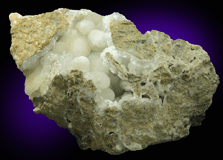
#357, Hydromagnesite, Spring Street at Medford
Road, Staten Island, New York
Sometimes labeled in old collections as washingtonite or menaconite (mennacanite) platy dark ilmenite crystals were found at 56th Street and Broadway in crystals to 50 mm embedded in limonite-stained quartz and at various localities in the Fort George region of upper Manhattan.
|
Platy metallic ilmenite var. Washingtonite from 56th Street at Broadway,
Manhattan, |
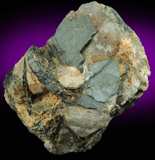
#340, Ilmenite var. Washingtonite in Quartz,
56th Street between Broadway and Sixth Avenue, Manhattan Island, New York
A common clay mineral, kaolinite is found in decomposed bedrock at various localities throughout the city. One specimen however is worthy of special mention: a well defined kaolinite pseudomorph after a terminated 5 cm diopside crystal found at 169th Street and Central Avenue in the Bronx currently resides in the NYMC collection. On Staten Island kaolinite clay was mined on the southwestern portion of the island for use in tile, brick and terra cotta.
|
Kaolinite pseudomorphous after diopside from 169th Street at Central Avenue, Bronx, NY 5 x 4 cm. NYMC #692. |
Present in the Manhattan schists throughout NYC, kyanite is associated with milky quartz and other rock-forming minerals. Specimens of blue kyanite crystals to 15 cm long in crystallized masses have been found in Manhattan, the Bronx, and Brooklyn. Kyanite is also found in the Inwood marble as lath-like white crystals to several centimeters. At 42nd Street and Park Avenue, near the current Grand Central Station, the bedrock had such a high kyanite content that it was labeled Kyanite Schist (NYAST, 1883). Other noteworthy occurrences include the excavations for Columbia University at 49th Street and Madison Avenue and the "richest deposit ever found in the city" (Chamberlin, 1888) at 101st Street between Lexington and Third Avenues where a kyanite vein was encountered during the expansion of the New York and Harlem Railroad tunnel.
Another late-forming zeolite found in bedrock fractures is laumontite that generally occurs as small white crystals associated with stilbite, pyrite and apophyllite-(KF). One noteworthy specimen in the AMNH collection is a cluster of blocky white 10 mm laumontite crystals found at Harold Avenue (an obsolete street name) in Long Island City, Queens.
Dark metallic magnetite crystals have been found throughout NYC. Magnetite is common as small crystals and grains in the serpentine deposits on Staten Island. In Manhattan, a find at 176th Street and Broadway had distinct parting planes that allowed collectors to cleave specimens into octahedral pseudo-crystals to 35 mm on edge (Manchester, 1914). Similar magnetite finds were made throughout upper Manhattan.
As mentioned above under copper, malachite occurred with copper and azurite in a specimen in the NYSM collection. Numerous other malachite specimens exist in other collections, mostly as green stains and microcrystals associated with altered copper minerals notably from Fort George, near 190th Street and Amsterdam Avenue.
Large blocky microcline crystals occurred in pegmatite dikes throughout NYC. Crystals as large as 12 cm were found in the Fort George section of upper Manhattan frozen in smoky quartz. Local collectors of the time patiently extracted the microcline crystals by slowly chipping away the surrounding quartz.
|
Microcline from Fort George, Manhattan, 12 x 9 x 6 cm. NYSM #315.10. |
|
Microcline crystal from Fort George, Manhattan, NY ex. Chamberlin, 12x8 cm. NYMC #385. |
Many monazite crystals, presumably monazite-(Ce), were recovered by Niven at 185th street at the Harlem River (see xenotime) during the construction of the Harlem Speedway. (It should be noted that the Harlem Speedway was the early name for the highway that is now the Harlem River Drive and is not a local racetrack.) At 171st Street and Fort Washington Avenue a series of three cavities in a pegmatite vein produced numerous parallel growths of monazite crystals, the largest reported by Hovey (1896a) to be a translucent brown crystal embedded in quartz and feldspar with the exposed portion measuring 13.5 mm long and 6.5 mm wide, with speculation that the crystal if fully exposed would measure 18 mm long. Harvard specimen No. 106322 is roughly the same dimensions and may in fact be the specimen described by Hovey.
|
Monazite-(Ce) 7 mm long from 171st St. and Fort Washington, Manhattan, |
|
Monazite-(Ce) crystal 13 mm long from 171st Street at Washington Avenue, Manhattan, NY. 4x4x3 cm overall. Harvard #106322 |
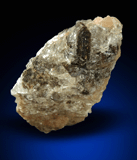
#355, Monazite-(Ce), Harlem Speedway, northeastern
shore of Manhattan Island, New York
Many muscovite mica crystals have been found in the pegmatites in the Manhattan Schists and gneisses and crystals to 38 cm are known (Manchester 1931). Large muscovite crystals exceeding 15 cm were found at the 171st Street at Fort Washington Avenue (Hovey 1896a). Frondel (1936) used over 100 muscovite crystals from Manhattan in his survey of oriented inclusions in mica (so-called Picture Micas).
|
Muscovite with magnetite inclusions from Riverside Drive, Manhattan, 21 x 17 cm. Staten Island Museum #SM471. |
Pink mica specimens were recovered from Water Tunnel No. 3, Shaft 7B under the Highbridge section of the Bronx, by tunnel geologist Bob Allen. These were thought to be lepidolite and would be the first NY state occurrence for that species. Testing by the NYSM in early 2008 concluded that these did not have lithium present and were simply rose-colored muscovite.
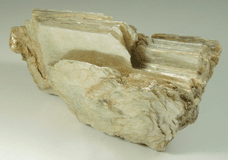
#359, Muscovite, Harlem Meer, in the northeast
corner of Central Park, New York
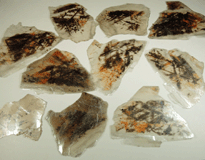
#327, Muscovite with oriented magnetite, rutile, hematite
inclusions, 93rd Street at Riverside Drive, Manhattan Island, New
York
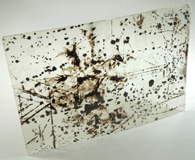
#361, Muscovite with oriented magnetite, rutile, hematite
inclusions, 93rd Street at Riverside Drive, Manhattan Island, New
York
Beck (1842) first mentions fetid-feldspar, an obsolete name for orthoclase, from Thomson's Quarry near 196th Street in the Kingsbridge section of upper Manhattan occurring in the Inwood marble. Early literature lists orthoclase as widely available throughout Manhattan and the Bronx in pegmatites, schist and gneiss, but early writers tended to label all potassic feldspars as orthoclase. Subsequent analysis has shown much of this material to be microcline, especially the material from the pegmatites. Early literature also sometimes used the obsolete name oligoclase, a calcium-rich variety of albite, for some samples that are actually also potassic feldspar and should be labeled orthoclase. This confusion should be kept in mind concerning the following historic examples.
An orthoclase 15 cm long and 10 cm across was reported at an NYAS meeting on April 2, 1888 and was cited as the largest orthoclase crystal found to date in Manhattan. Other noteworthy occurrences include: lustrous flesh-colored crystals from 96th Street at Park Avenue; a twinned crystal in the Kunz collection from Fort George; fine groups of orthoclase crystals overgrown with albite from 96th Street near 3rd Avenue; highly modified partially altered crystals to 15 cm long from a decomposed pegmatite at 43rd Street and 1st Avenue (Chamberlin, 1888).
|
Orthoclase with quartz and adularia from Lafayette Avenue, Brooklyn, |
The Chamberlin collection of the NYMC has a large, well developed 6 cm orthoclase crystal in smoky quartz labeled as simply from Manhattan - a common occurrence in Chamberlin's collection because many were collected in undeveloped portions of the island before the roadways were laid out.
Manchester (1940) reported that he found a well developed orthoclase crystal was found at 161st Street and Broadway when he spotted the specimen at a building excavation. Having no tools at the time, he was forced to return the following day, after an overnight snowstorm. After spending much time sweeping away the accumulated snow, he was able to locate the orthoclase crystal and successfully extract the specimen, which was pictured as Plate No. 39 in his 1931 book.
Orthoclase, variety adularia, has been collected during recent work on Water Tunnel No. 3 under Manhattan and has been confirmed by analysis at the NYSM. It is reported as occurring in localities as diverse as the Jerome Park Reservoir in the Bronx and Lafayette Avenue in Brooklyn (most likely from glacial deposits).
|
Pyrite crystal 2 mm across on orthoclase crystals to 3 mm from dumped rock
in N.J. meadowlands from |
Robinson (1825) first lists pyrite as occurring in the Inwood marble from the Kingsbridge section of Manhattan. Chamberlin (1888) reported the best pyrite crystals he collected were cubic with octahedral and trapezohedral edge modifications, 25 mm across, collected at St. Ann's Avenue and 145th Street in the Bronx. Moses (1890-91) describes Kingsbridge pyrite crystals as predominantly octahedral form, modified by three or more secondary forms, and he noted that the pyrite crystals that occurred in cavities associated with quartz crystals were consistently cubic form and smaller than average. One asymmetric single crystal 18 mm across was collected by Gilman Stanton and is currently in the collection of Steve Nightingale. The NYSM has a 9 mm pyrite crystal with octahedral corner faces from Dyckman Street in upper Manhattan. A 15 mm pyrite crystal showing pyritohedral form modified by cubic faces on the edges was collected by Irving Horowitz in 1935 from the rock excavated for the Harlem Ship Canal and deposited on the western shore of Manhattan Island at the end of Dyckman Street. In the late 1990s Ted Zirnite collected a distorted pyrite crystal 16 mm long at the same locality, near the marina at Tubby Hook.
|
Pyrite on calcite from Water Tunnel #3, shaft 19B, Brooklyn, NY 18 mm diameter, collected by Brad Plotkin in 1993. |
Crystals of pyrite to 25 mm across were found in the rocks excavated from the Brooklyn-Battery Tunnel (Lisle, 1947). Recently, clusters of 3-9 mm cubic pyrite crystals were recovered in Water Tunnel No. 3 under Manhattan and in 1993 Brad Plotkin collected a spherical formation 18 mm in diameter of crystallized pyrite from rock dumped during the excavation of Shaft 19B for the tunnel at Grand Avenue and Page Place in Brooklyn.
|
Pyrite and calcite on stilbite from Water Tunnel No. 3, 700' level, Station167,
under Woodside, Queens |
|
Limonite pseudomorphous after 10 mm pyrite from Broadway at 207th Street,
Manhattan, NY |
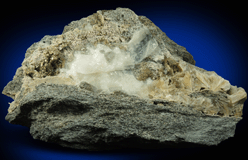
#330, Pyrite and Stilbite-Ca in Calcite-filled
vein, Harlem Meer, in the northeast corner of Central Park, New York
Pyrite crystals also occur with stilbite and other zeolites as late-forming minerals in bedrock faults and fractures. These pyrite crystals seldom exceed 2 mm because of the constricted growth environment.
Many specimens of pyrrhotite are in the NYMC collection, but most are highly oxidized due to weathering. The pyrrhotite forms thin hexagonal crystals filling narrow cavities with most being from the Inwood marble at the north end of Manhattan Island. A vein 2.5 cm thick of massive pyrrhotite was encountered running through the Inwood marble at the Harlem Ship Canal (Conklin, 1997).
Amethyst, smoky and milky quartz have been found in many NYC localities in all 5 boroughs. Both milky and smoky varieties of quartz were found in seams and lens-shaped cavities in the Inwood marble of the Kingsbridge area of northern Manhattan Island. Small geode-shaped formations lined with dolomite crystals with overgrowths of smaller quartz crystals were found the same region (Bates, 1895). A large 10x7 cm plate of smoky quartz with individual crystals to 12 mm long recovered during the excavation of the Harlem Ship Canal through the Inwood marble is now in the NYMC collection.
Large colorless quartz crystals as large as 80 mm long are in the NYSM collection from an unknown location in Manhattan. A large 55 mm pale-smoky quartz crystal from 176th Street at 10th Avenue was in a collection the NYSM acquired from George Kunz. The NYMC collection has a 120 mm milky quartz crystal from Westchester Avenue in the Bronx.
|
Quartz labeled simply as from Manhattan, NY ex. Kunz, 6x3x2 cm. NYSM #1355. |
On Staten Island quartz is a common product of weathering serpentine and limonite-stained quartz crystals were found throughout the serpentine highlands, notably at Todt Hill and the old Johns Co. quarry on Ward Hill. One unique quartz oddity was a perfectly spherical quartz group 16 mm diameter from Lincoln Avenue, Grant City on Staten Island.
|
Spherical quartz nodule from Lincoln Avenue, Grant City, Staten Island, NY.
|
A doubly-terminated smoky quartz scepter-like crystal 37 mm long is in the collection of Steven Chamberlain. This specimen was originally collected in April 1938 from the rock being dumped in Flushing Bay in northern Queens, probably from the fill being used to construct LaGuardia Airport that opened in December 1939.
|
Quartz var. Smoky from rock dump in Flushing Bay, Queens, NY April, 1938,
|
Fred Pough, NYMC member and former curator of the AMNH donated a plate of light-purple amethystine quartz to the AMNH from 246th Street and Independence Avenue in the Riverdale section of the Bronx.
Recently Michael Walter collected many small clusters of transparent quartz crystals to 12 mm long from a quartz vein cutting the Manhattan schist at 104th Street on the western edge of Central Park. Another recent find, and still accessible is beneath the Hudson Bridge connecting northern Manhattan to the Riverdale section of the Bronx, small cavities in a dense gray limestone matrix contain colorless quartz crystals to 12 mm long. These specimens are found in the loose rock at the river's edge and possibly originated elsewhere and were brought in as fill.
|
Quartz cluster from 104th Street at Central Park West in Central Park, Manhattan, NY 6 x 3 x 2 cm collected by Michael Walter in the 1980s. |
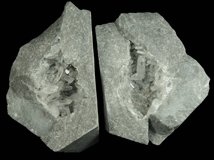
#352, Quartz, Northern tip of Manhattan Island
beneath the Henry Hudson Bridge, New York
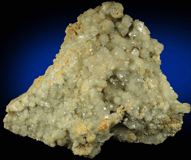
#334, Quartz var. Green Quartz, Signal Hill,
Staten Island, New York
The first mention of rutile from New York City was in 1814 (Bruce, 1814a) referring to crystals found in the Inwood marble at the northern end of Manhattan Island. Many rutile crystals have been found in this region and are widely represented in major collections. The rutile occurs in quartz-mica-feldspar veins and dikes cutting through the marble. Translucent dark-red rutile crystals with lustrous crystal faces are among the most aesthetic minerals found in NYC, though also among the smallest. Chamberlin (1885) reported finding reticulated rutile crystals on gneiss near the entrance to Central Park at 105th Street and 5th Avenue and includes two illustrations of the formations. Manchester (1914, Figure 15) illustrates a single water-clear quartz crystal with two dark rutile crystals extending to one side from 218th Street and Broadway, where the largest rutile crystals known were 54 mm long. Kunz (1887) reported rutile crystals as large as 25 mm long from the Fort George section of upper Manhattan.
|
Rutile crystal 7 mm long in Inwood Marble from Kingsbridge (Inwood), Manhattan, NY., 3 x 2 x 1 cm, NYSM #21408. |
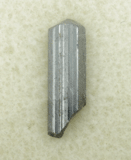
#371, Rutile, Harlem Ship Canal excavation,
norther Manhattan Island, New York

#362, Rutile, Harlem Ship Canal excavation,
norther Manhattan Island, New York
Beck (1842) mentions black tourmaline (schorl) from many parts of NYC, notably from the railroad excavation in Harlem. Hovey (1886a) reports many lustrous black schorl crystals were found at 171st Street at Fort Washington Avenue including one large schorl crystal 24 cm long embedded in granular gray quartz. Many specimens from this find are currently in the NYC collection at the AMNH.
|
Schorl tourmaline from an April 1969 bank foundation excavation on South Street, Manhattan, NY. dumped in NJ meadowlands. 7x4 cm. Collected by Dietmar Stitz. |
|
Schorl crystal 50 mm long in quartz from 96th Street and Park Avenue, Manhattan, NY., 10 x 6 cm, ex. Chamberlin NYMC #637. |
Elsewhere in Manhattan, many lustrous schorl crystals were found during the expansion of the New York and Harlem Railroad tunnel, also called the Harlem Tunnel, in the vicinity of 100th Street and Park Avenue where schorl crystals as large as 12 cm long were collected from a quartz vein in the gneiss (Chamberlin, 1888). One exceptionally large schorl crystal measuring 30.5 cm long and 7.5 cm diameter was recovered by F.W. Miller (1910) from a foundation excavation at 157th Street near Fort Washington Avenue. This specimen is in the NYMC collection and is impressive despite it being in three sections. Lisle (1947) reported many black schorl tourmaline crystals to 25 mm long embedded in quartz at the rock excavated from the construction of the Brooklyn-Battery Tunnel. The best specimen from this find was 15 cm across and contained 14 unbroken schorl crystals to 19 mm long.
|
Radiating crystal groups of schorl tourmaline on quartz from 170th St. and Amsterdam Ave. Manhattan, NY 11x6 cm. NYMC #630. |
The rock excavated from NYC was commonly used as fill in the surrounding areas, notably in the meadowlands of New Jersey where mineral collectors had easy access. At the meadowlands fill Dietmar Stitz collected a fan-shaped group of lustrous black schorl crystals 20-30 mm long embedded in smoky quartz. More recently David Miller collected several similar black schorl crystals as large as 50 mm long from the fill in Overpeck Park, at the north end of Overpeck Creek in the meadowlands.
Recently the author recovered a schorl crystal 30 mm in diameter in milky quartz during the reconstruction of the Harlem Meer (pond) in the northeast corner of Central Park in Manhattan. The schorl crystal was in segments averaging 25 mm long frozen in the quartz with quartz filling the space between the segments.
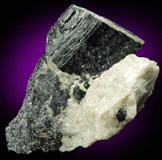
#351, Schorl Tourmaline, Harlem Meer, in the
northeast corner of Central Park, New York
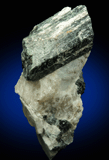
#365, Schorl Tourmaline, Harlem Meer, in the
northeast corner of Central Park, New York
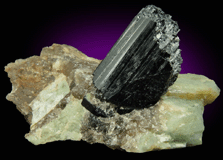
#350, Schorl Tourmaline in Quartz-Albite, west
shore of Manhattan Island at 102 Street, New York
Not all garnet crystals from NYC are almandine, many proved to be spessartine. Red-orange spessartine garnet crystals were found at Haven Avenue and 179th Street under the eastern end of the George Washington Bridge. The largest crystal found was 10 cm across and was distorted trapezohedron in shape (Manchester and Stanton, 1917). One partial crystal was gem-grade and produced the sixteen faceted gemstones illustrated in Manchester (1931) Plate No. 1. An 11x8 mm oval cabochon of red spessartine from this same locality, formerly from Gilman Stanton's collection, currently resides in the collection of Steve Nightingale. The NYSM has a compound cluster of trapezohedral 20 mm spessartine crystals from the Battery Tunnel connecting Manhattan and Brooklyn.
|
Spessartine garnet from Brooklyn Battery Tunnel, Manhattan, NY 30x22x18 mm NYSM #21868. |
A new addition to the list of species occurring in NYC is stichtite, recently found at Lincoln Avenue on Staten Island by Tod Jorgensen. The stichtite occurs as lilac-purple microcrystals filling fractures in greenish serpentine.
The most widely represented mineral from NYC is stilbite (presumably Stilbite-Ca), due to it's widespread distribution and aesthetic formations. Stilbite commonly occurs as radiating formations filling thin fractures in the bedrock associated with heulandite, chabazite and harmotome. The first mention of stilbite (Robinson, 1825) describes red to deep-red six-sided stilbite crystals from West Farms, now the Tremont section of the Bronx. Beck (1842) reported reddish to yellow stilbite, associated with mesolite and epidote, in narrow veins running through the gneiss at the New York and Harlem Railroad tunnel, an old locality near 122nd Street. Beck also reports stilbite associated with chabazite, heulandite and epidote in the West Farms area of the Bronx.
Occasionally, when the width of the fracture is large enough, hemispherical stilbite crystal rosettes fully form as from the localities at 45 Street between 1st and 2nd Avenues where specimens 60 cm across were recovered; 129th Street at Convent Avenue and at 96th Street at Park Avenue, all in Manhattan.
|
Stilbite from Water Tunnel #3 under Roosevelt Island, NY County, 5 x 8 x 3 cm collected in 1970 by Dietmar Stitz. |
In the 1970s the construction of the 63rd Street subway resulted in excavated rock from the project being dumped in College Point, Queens where local collectors routinely found plates of colorful red-orange stilbite crystals as large as 10 mm.
Most recently impressive plates exceeding 50 cm across of red-orange to brown stilbite crystals were recovered by Dietmar Stitz in the 1970s from Water Tunnel No. 3 before the implementation of tunnel boring machines. Currently the tunnel boring machines restrict collecting opportunities to the fault zones exposed after the machine has passed. Dr. Charles Merguerian, the project geologist for one section of the tunnel, recovered many plates covered with tan-colored stilbite crystals to 4 mm associated with colorless calcite and pyrite microcrystals, notably from the 700' level, Station167, under Woodside, Queens.
|
Stilbite from Water Tunnel #3, Queens, NY 7.5x4x2 cm. NYSM #21717B. |
|
Calcite crystals on stilbite from Water Tunnel No.3 under Roosevelt Island,
NY County, NY |
|
Stilbite crystals to 4 mm long from 92nd Street at Lexington Ave. Manhattan
9x5x6 cm overall. |
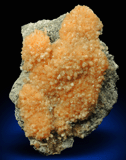
#367, Stilbite, Water Tunnel No.3 under Manhattan
Island, New York
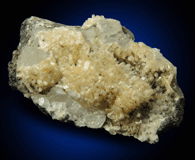
#370, Stilbite on Calcite with (?), 63rd Street
Subway Tunnel, Manhattan Island, New York
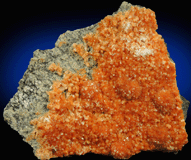
#341, Stilbite-Ca, Water Tunnel No.3 under Manhattan
Island, New York
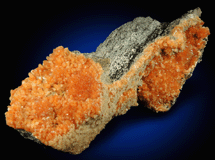
#335, Stilbite-Ca and Calcite, Water Tunnel
No.3 under Manhattan Island, New York
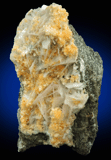
#344, Stilbite-Ca and Calcite, Water Tunnel
No.3 under Roosevelt Island, New York
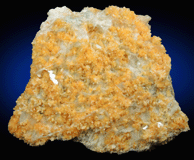
#345, Stilbite-Ca and Calcite, Water Tunnel
No.3 under Roosevelt Island, New York
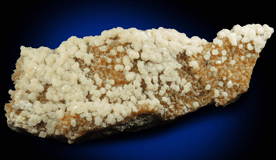
#331, Stilbite-Ca and Calcite with minor Pyrite,
700' level, Sta.167, Queens Tunnel of NYC Water Tunnel #3, New York

#360, Stilbite-Ca on Calcite, IRT Pelham Line
Subway under Southern Boulevard, Bronx, New York
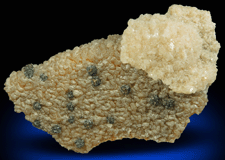
#329, Stilbite-Ca with Calcite and Pyrite (best of
find), 700' level, Sta.167, Queens Tunnel of NYC Water Tunnel #3,
New York
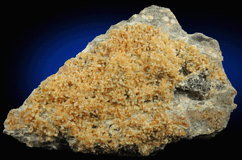
#342, Stilbite-Ca with minor Muscovite, Water
Tunnel No.3 under Manhattan Island, New York
Go to Previous Page, Page 1, Page 2, Page 3, Page 4, Next Page
Online Museum of New York City minerals
John Betts - Fine Minerals Home Page
Please support our sponsor
© The Minerals of New York City, by John H. Betts - All Rights Reserved